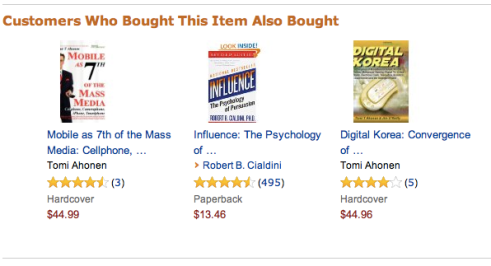It’s that time of year, everyone’s going crazy with their Christmas shopping and trying to decide what would be the perfect gift for the whole family. Instead of us seeing the panic in everyone’s faces whilst they run around the high street, instead we have been gifted with silence. The main reason that this change has happened is mainly due to more people choosing to browse the web and order their presents that way instead of going out to do the shopping.
The main focus here isn’t necessarily the use of e-commerce and Christmas but the power of recommendation or ‘Recommendation Agents’ within certain websites. These RAs are defined as being software agents that elicit the interests or preferences of users by recommending something as an alternative (Xiao & Benbasat, 2007). Whilst Grenci and Todd (2002) state that RAs are characterized as being some sort of customer support system or DSS.

RAs work by using the information inputted by the customer when they are searching for a product. This information is then used to offer different alternatives or recommendations based off of what has been searched previously (Xiao & Benbasat, 2007). It is said that the customers who are being offered these RAs are known to be facing certain problems known as “preferential choice problems” (Todd & Benbasat, 1994). One of the main problems with these RAs is the fact that the literature only focuses on the processes that are used to create them, however Xiao and Benbasat (2007) focus on more than just these processes, instead they focus on the; inputs, processes, outputs, source credibility, and product/user related factors.
The use of RAs assist with the consumers shopping task, not by making it easier but instead by influencing their decision-making (Xiao & Benbasat, 2007). Due to how complex some decision making environments can be (we’ve all been there), Payne (1982) believes that this complexity can actually be reduced by using a two-stage decision making process. Firstly, we as individuals will scan through a large selection of different alternatives where we would go on to choose a specific subset of what we believe to be the best candidates. This would then lead to us evaluating and comparing the alternatives before we are able to commit to the alternative we want to choose (Edwards & Fasolo, 2001).

The use of these RAs can be seen in any shopping website, however I believe Amazon are one of the main users of this method. Whenever I shop I don’t always go for my first choice, instead I read the reviews and if they are seen to be poor then I would move on to one of the recommendations that Amazon have offered me in their little scroll bar. Due to these recommendations being based on what I have searched I always find certain products that aren’t from my last search, instead they come from other searches that have occurred at an earlier date instead.
Next time you shop, pay attention to your recommendations. You might find something that shouldn’t belong there.
References
Edwards, W., & Fasolo, B. (2001). Decison Technology . Annual Review of Psychology , 581-606.
Grenci, R. T., & Todd, P. A. (2002). Solutions-Driven Marketing . Communications of the ACM, 64-71.
Payne, J. W. (1982). Contingent Decision Behaviour . Psychological Bulletin , 382-402.
Todd, P., & Benbasat, I. (1994). The Influence of Decision Aids on Choice Strategies: An Experimental Analysis of the Role of Cognitive Effort . Organizational Behaviour and HUman Decision Processes, 36-74.
Xiao, B., & Benbasat, I. (2007). E-commerce product recommendation agents: use, characteristics, and impact. MIS Quarterly, 137-209.

Hi TheUltimateConsumer and thank you for such a well researched and interesting post.
I really like how you have highlighted the role of Recommendation Agents as a customer support system.
Recommendation Agents are interesting, as they can recommend additional products as well as alternative equivalent products.
For example your Amazon screenshot showing the 3 alternative book choices. If we assume these are alternative equivalents to the product on that page, then the potential risk of proposing them is that they introduce additional items into the consideration set and invoke a paradox of choice which has been shown to reduce purchases (Lyengar et al, 2000)
A possible explanation could be provided by the Shopping Momentum Effect (Dhar et al, 2007). Once a person has chosen an item (the deliberative phase), they move from a browsing phase into an implementation phase (the ‘going through with the purchase’ phase). If additional products are presented while shoppers are in this second phase, they buy more. It’s like people build up ‘Shopping Momentum’ and this happens even if the subsequent items are unrelated to the first.
Cleverly, Amazon disguise this device to increase customer spend under the banner of being helpful and also mix in a dose of social norm. The wording (Customers who bought this also bought…) suggests a social norm to the purchasing of these additional items. It also implies that the suggested books were bought in addition to the product being viewed.
Amazon are renowned for the care and attention they place on how their site affects customer purchasing behaviours and i’m sure this will have been shown to be beneficial.
References
Dhar, R., Huber, J., & Khan, U. (2007). The shopping momentum effect. Journal of Marketing Research, 44(3), 370-378.
Iyengar, S. S., & Lepper, M. R. (2000). When choice is demotivating: Can one desire too much of a good thing?. Journal of personality and social psychology, 79(6), 995.
LikeLike